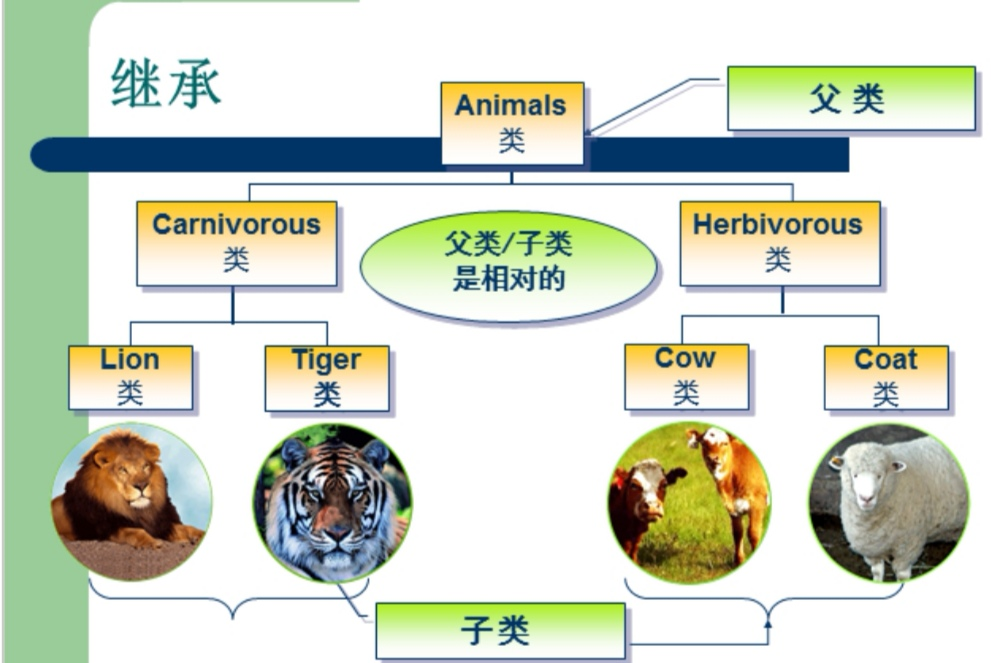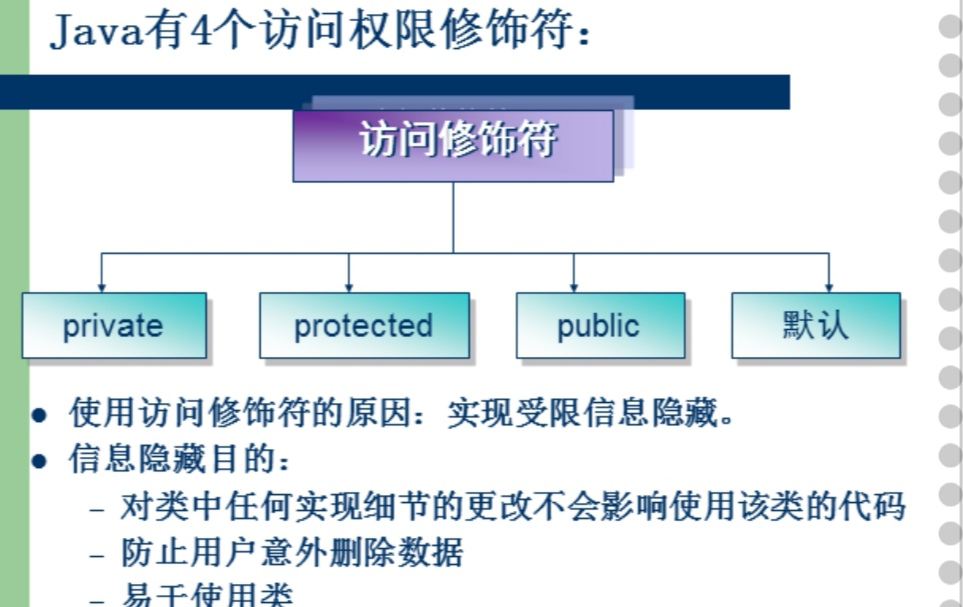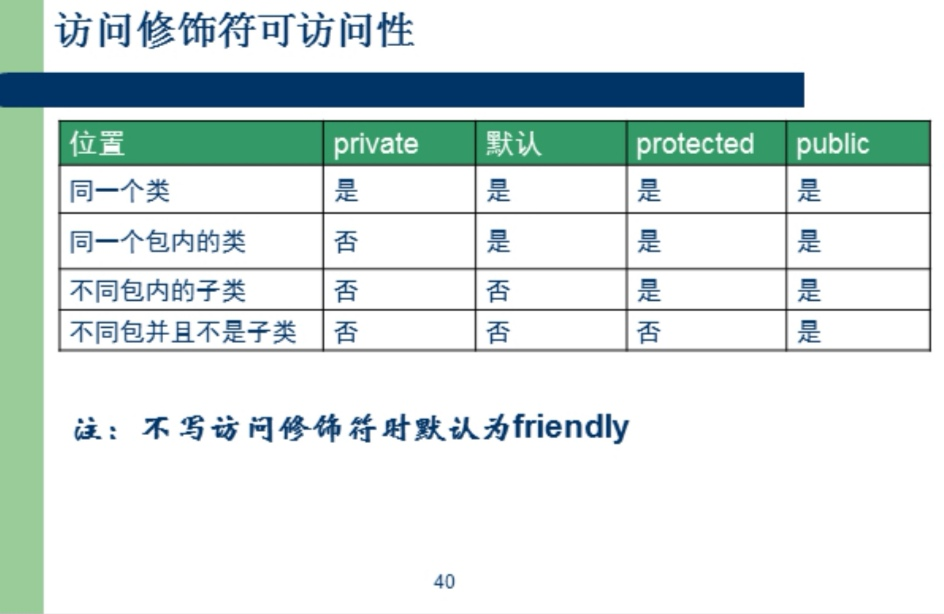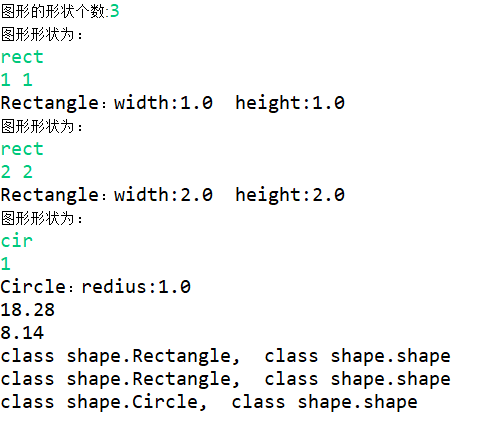201871010106-丁宣元 《面向对象程序设计(java)》第六—七周学习总结
正文开头
|
项目 |
内容 |
|
这个作业属于哪个课程 |
https://www.cnblogs.com/nwnu-daizh/ |
|
这个作业的要求在哪里 |
https://www.cnblogs.com/nwnu-daizh/p/11605051.html |
|
作业学习目标 |
|
正文内容
第一部分:总结第五章理论知识
5.1 类、超类和子类
1.继承:(1)用已有类来构建新类的一种机制。当一个新类继承了一个类时,这个新类就继承了这个类的方法和域,可以在新类中添加新的方法和域。eg:Empolyee,manager在Empolyee的情况下有奖金,即新方法和域。

(2)继承的特点:具有层次结构,子类继承父类的域和方法。
(3)继承的优点:代码可重用性,父类的域和方法可用于子类,设计应用程序变得更加简单,可以轻松定义子类。
(4)语法格式:class 新类名 extends 已有类名 子类比超类拥有的功能更加丰富
已有类也称超类(superclass),基类(base class),父类(parent class)
新类也称子类(subclass),派生类(derived class),孩子类(child class)
通过扩展超类定义子类时,仅需指出不同,子类中可以增加覆盖但不可删除
若子类没有显示的调用超类的构造器,则自动调用超类默认构造器
(5)子类的构造器不能直接访问超类的私有域,必须调用超类构造器,且必须是第一条语句。
(6)super:一个指示编译器调用超类方法的特有关键字,不是一个对象的引用,不能将super赋给另一个对象变量。
两个用途:调用超类的方法(格式:super.方法名())
调用超类的构造器(格式:super() )
子类不继承父类的构造方法,用super调用。覆盖只能在不同的类中完成。
2.继承层次:
(1)定义:从一个超类扩展而来的类集合称为层次继承。
(2)Java不支持多继承:一个父类可以有多个子类,一个子类只能有一个父类。
3.多态性:
(1)定义:泛指在程序中同一个符号在不同情况下具有不同解释
超类中定义的域或方法,被子类继承之后,可以具有不同的数据类型或表现出不同的行为,这使得在超类及其子类中同名的域或方法具有相同的语义。超类中的方法在子类中可方法重写。
4.抽象类:
a.定义:
abstract class Person
{
public abstract String getDescription();
......
}
abstract 方法,只能声明,不能实现
b.
(1)为了提高程序的清晰度,包含一个或多个抽象方法的类本身必须被声明为抽象类。抽象类可以包含具体数据和具体方法
(2)抽象方法充当着占位的角色,它们的具体实现在子类。扩展抽象类有两种选择:一在子类中实现部分抽象方法,这样就必须将子类也标记为抽象类;二实现全部抽象方法,这样子类就可以不是抽象类。类即使不含抽象方法,也可以将类声明为抽象类。
(3)抽象类不能被实例化,即不能创建对象,只能产生子类。
5.动态绑定:
a.定义:也称为运行时绑定,程序在运行时会自动选择调用哪个方法。
eg:public class Son extends Father
{...}
Son son=new Son();
son.method();
b.执行过程:以上述为例
编译器检查对象的声明类型和方法名,搜索相应类(Son)及其父类(Father)“方法表”,找出所有访问属性为public的method方法。
->编译器检查方法调用中提供的参数类型,找出一个完全匹配的方法,称为重载解析。
->如果方法是private、static、final修饰的,或者是构造器,那么编译器能准确地判断应该调用哪个方法,即静态绑定。
->程序运行时,如果Son中定义了mothod()方法,直接调用子类中的相应方法;如果没有定义,则在父类中寻找method()的方法。
动态绑定中每一次调用方法都要进行搜索,时间花费大。因此虚拟机预先为每个类创建了一个方法表,列出了所有方法的签名和实际调用的方法。方法的签名:方法的名称和参数列表称为方法的签名
6.阻止继承:final类和方法
不允许继承的类称为final类,在类的定义中用final修饰符
类中的方法定义为final,子类就不能覆盖该方法
如果一个类声明为final,属于它的方法会被自动设为final,但不包括域
7.强制类型转换
(1)把一个超类对象赋给一个子类对象变量,就必须进行强制类型转换。
语法:子类 对象= (子类) (超类对象)
类型转换必须在继承层次内进行,在超类转换为子类之前,先用instanceof操作符进行继承链检查。(少使用)
注:
(1)封装、继承你和多态性是面向对象的主要特征;
(2)继承可提高代码的重用性,用extends关键字来实现。
(3)继承建立了类与类之间的关系,也是多态特征的前提
(4)支持单继承,不直接支持多继承
(5)abstract修饰符的抽象类不能被实例化为对象,只能扩展子类。抽象类中的抽象方法充当着占位的角色,它们的具体实现在子类中。
(6)final类不允许被继承;类中final 方法不允许被子类重写。
(7)权限访问修饰符


5.2 Object:所有类的超类
1.Object类是Java中所有类的祖先——每一个类都由它扩展而来。可以使用类型为Object的变量指向任意类型的对象。但要进行强制类型转换。
2.equals方法:检测某个对象是否同另一个对象相等。判断两个对象是否相等的引用:如果有相同的引用,是相等的;
定义子类的equals方法:super. equals (otherObjecct)
3.hashCode方法:hashCode方法导出某个对象的散列码。两个相等对象的散列码相等。
4.toString方法:toString方法返回一个代表该类对象域值的字符串
定义:super.toString()
5.3 泛型数组列表
1.ArrayList类,可允许程序在运行时确定数组的大小;
2.ArrayList是一个采用类型参数的泛型类。为指定数组列表保存元素的对象类型,需要用一对尖括号将数组元素的对象类名括起来加在后面;
3.数组列表的操作:
定义:ArrayList<T> 对象 = new ArrayList<T>()
API:ArrayList的构造器 添加新元 统计个数 调整大小 访问 增加与删除
5.4 对象包装器和自动打包
a所有基本数据类型都有与之对应的预定义类,被称为对象包装器。
b对象包装器类是不可变的,一旦构造了包装器,不允许更改值
c好处:基本类型转换为对象 ,定义一些有用的基本方法(static方法)
d自动打包:自动的将基本数据类型转换为包装器类的对象
5.5 参数变量可变的方法:用户自己可以定义可变参数的方法,并将参数指定为任意类型,甚至是基本类型
5.6 枚举类
(1)声明枚举类:public enum Grade{A、B、C、D、E}
注:枚举类是一个类,它的隐含超类是java.lang.Enum。
枚举值并不是整数或其它类型,是被声明的枚举类的自身实例
不能有public修饰的构造函数,构造函数都是隐含private,编译器自动处理。
隐含都是由public、static、final修饰的,无须自己添加这些修饰符。
比较两个枚举类型的值时,不需要调用equals方法,直接使用“==”。
5.7 继承设计的技巧
将公共操作和域放在超类。
不要使用受保护的域。
使用继承实现“is-a”关系。
除非所有继承的方法都有意义,否则就不要使用继承。
在覆盖方法时,不要改变预期的行为。
使用多态,而非类型信息。
第二部分:实验部分
1.实验目的与要求
(1) 理解继承的定义;
(2) 掌握子类的定义要求
(3) 掌握多态性的概念及用法;
(4) 掌握抽象类的定义及用途。
2.实验内容和步骤
实验1:导入第5章示例程序,测试并进行代码注释。
测试程序1
在elipse IDE中编辑、调试、运行程序5-1 —5-3(教材152页-153页) ;
掌握子类的定义及用法;
结合程序运行结果,理解并总结OO风格程序构造特点,理解Employee和Manager类的关系子类的用途,并在代码中添加注释;
删除程序中Manager类、ManagerTest类,背录删除类的程序代码,在代码录入中理解父类与子类的关系和使用特点。
1.程序代码
5-1MangerTest.java
package inheritance; /** * This program demonstrates inheritance. * @version 1.21 2004-02-21 * @author Cay Horstmann */ public class ManagerTest { public static void main(String[] args) { // construct a Manager object var boss = new Manager("Carl Cracker", 80000, 1987, 12, 15); boss.setBonus(5000); //bouns在Manager类中初值为空,用更改器改为5000 var staff = new Employee[3]; //构造器 // fill the staff array with Manager and Employee objects staff[0] = boss; //父类对象可以引用子类对象 staff[1] = new Employee("Harry Hacker", 50000, 1989, 10, 1); staff[2] = new Employee("Tommy Tester", 40000, 1990, 3, 15); // print out information about all Employee objects for (Employee e : staff) System.out.println("name=" + e.getName() + ",salary=" + e.getSalary()); //多态性质 } }
5-1Employee.java
package inheritance; import java.time.*; public class Employee { private String name; //创建三个私有属性 private double salary; private LocalDate hireDay; public Employee(String name, double salary, int year, int month, int day) { this.name = name; this.salary = salary; hireDay = LocalDate.of(year, month, day); } public String getName() { return name; } public double getSalary() { return salary; } public LocalDate getHireDay() { return hireDay; } public void raiseSalary(double byPercent) { double raise = salary * byPercent / 100; salary += raise; } }
5-1Manger.java
package inheritance; public class Manager extends Employee //extends继承 { private double bonus;//私有域 /** * @param name the employee's name * @param salary the salary * @param year the hire year * @param month the hire month * @param day the hire day */ public Manager(String name, double salary, int year, int month, int day) { super(name, salary, year, month, day);//子类对的构造器不能直接访问超类的私有域,必须调用超类构造器,且必须是第一条语句 bonus = 0; } public double getSalary() { double baseSalary = super.getSalary();//子类不能直接访问超类的私有域,必须使用共用接口 return baseSalary + bonus; } public void setBonus(double b) { bonus = b; } }
2.运行结果

背录删除类的程序代码
package inheritance; public class Manager extends Employee { private double bonus; public Manager(String name, double salary, int year, int month, int day) { super(name, salary, year, month, day); // TODO Auto-generated constructor stub bonus=0; } @Override public double getSalary() { double baseSalary = super.getSalary();//子类不能直接访问超类的私有域,必须使用共用接口 return baseSalary + bonus; // TODO Auto-generated method stub //return super.getSalary(); } /*public double getBonus() { return bonus; }*/ public void setBonus(double b) { //this.bonus = bonus; bonus = b; } }
package inheritance; /** * This program demonstrates inheritance. * @version 1.21 2004-02-21 * @author Cay Horstmann */ public class ManagerTest { public static void main(String[] args) { // construct a Manager object var boss = new Manager("Carl Cracker", 80000, 1987, 12, 15); boss.setBonus(5000); var staff = new Employee[3]; // fill the staff array with Manager and Employee objects staff[0] = boss; staff[1] = new Employee("Harry Hacker", 50000, 1989, 10, 1); staff[2] = new Employee("Tommy Tester", 40000, 1990, 3, 15); // print out information about all Employee objects for (Employee e : staff) System.out.println("name=" + e.getName() + ",salary=" + e.getSalary()); }

关系:先有父类,再有子类,先析构子类,再析构父类
1.子类对象在创建时会首先调用父类的构造函数
2. 父类构造函数执行结束后,执行子类的构造函数
3. 当父类的构造函数有参数时,需要在子类的初始化列表中显示调用
4. 析构函数调用的先后顺序与构造函数相反
实验1:测试程序2
编辑、编译、调试运行教材PersonTest程序(教材163页-165页);
掌握超类的定义及其使用要求;
掌握利用超类扩展子类的要求;
在程序中相关代码处添加新知识的注释;
删除程序中Person类、PersonTest类,背录删除类的程序代码,在代码录入中理解抽象类与子类的关系和使用特点。
1.程序代码
5-4PersonTest.java
package abstractClasses; /** * This program demonstrates abstract classes. * @version 1.01 2004-02-21 * @author Cay Horstmann */ public class PersonTest { public static void main(String[] args) { var people = new Person[2]; // fill the people array with Student and Employee objects 用Employee类和Student类填充people数组 people[0] = new Employee("Harry Hacker", 50000, 1989, 10, 1); people[1] = new Student("Maria Morris", "computer science"); // print out names and descriptions of all Person objects打印信息 for (Person p : people) System.out.println(p.getName() + ", " + p.getDescription()); } }
5-5Person.java
package abstractClasses; public abstract class Person //抽象类Person,包含一个或多个抽象方法的类必须被声明为抽象的 { public abstract String getDescription(); private String name;//私有属性 public Person(String name)//构造器 { this.name = name; } public String getName()//访问器 { return name; } }
5-6Empolyee.java
package abstractClasses; import java.time.*; public class Employee extends Person//子类Employee类继承Person类 { private double salary; private LocalDate hireDay; public Employee(String name, double salary, int year, int month, int day) { super(name);//子类中直接调用超类中的name this.salary = salary; hireDay = LocalDate.of(year, month, day); } public double getSalary() { return salary; } public LocalDate getHireDay() { return hireDay; } public String getDescription() { return String.format("an employee with a salary of $%.2f", salary); } public void raiseSalary(double byPercent) { double raise = salary * byPercent / 100; salary += raise; } }
5-7Student.java
package abstractClasses; public class Student extends Person //子类Student类继承Person类 { private String major;//私有属性 /** * @param name the student's name * @param major the student's major */ public Student(String name, String major) { // pass name to superclass constructor super(name);//子类调用超类中的name属性 this.major = major; } public String getDescription() { return "a student majoring in " + major; } }
2.运行结果

删除程序中Person类、PersonTest类,背录删除类的程序代码
package abstractClasses; public abstract class Person { public abstract String getDescription(); public String getName() { return name; } public void setName(String name) { this.name = name; } private String name; public Person(String name){ // TODO Auto-generated constructor stub this.name = name; } }
package abstractClasses; /** * This program demonstrates abstract classes. * @version 1.01 2004-02-21 * @author Cay Horstmann */ public class PersonTest { public static void main(String[] args) { var people = new Person[2]; // fill the people array with Student and Employee objects people[0] = new Employee("Harry Hacker", 50000, 1989, 10, 1); people[1] = new Student("Maria Morris", "computer science"); // print out names and descriptions of all Person objects for (Person p : people) System.out.println(p.getName() + ", " + p.getDescription()); } }

实验1:测试程序3
编辑、编译、调试运行教材程序5-8、5-9、5-10,结合程序运行结果理解程序(教材174页-177页);
掌握Object类的定义及用法;
在程序中相关代码处添加新知识的注释。
1.程序代码
5-8EqualsTest.java
package equals; /** * This program demonstrates the equals method. * @version 1.12 2012-01-26 * @author Cay Horstmann */ public class EqualsTest //主类 { public static void main(String[] args) { var alice1 = new Employee("Alice Adams", 75000, 1987, 12, 15); var alice2 = alice1; var alice3 = new Employee("Alice Adams", 75000, 1987, 12, 15); var bob = new Employee("Bob Brandson", 50000, 1989, 10, 1); System.out.println("alice1 == alice2: " + (alice1 == alice2)); System.out.println("alice1 == alice3: " + (alice1 == alice3)); System.out.println("alice1.equals(alice3): " + alice1.equals(alice3)); System.out.println("alice1.equals(bob): " + alice1.equals(bob)); System.out.println("bob.toString(): " + bob); var carl = new Manager("Carl Cracker", 80000, 1987, 12, 15); var boss = new Manager("Carl Cracker", 80000, 1987, 12, 15); boss.setBonus(5000); System.out.println("boss.toString(): " + boss); System.out.println("carl.equals(boss): " + carl.equals(boss)); System.out.println("alice1.hashCode(): " + alice1.hashCode()); System.out.println("alice3.hashCode(): " + alice3.hashCode()); System.out.println("bob.hashCode(): " + bob.hashCode()); System.out.println("carl.hashCode(): " + carl.hashCode()); } }
5-9Empolyee.java
package equals; import java.time.*; import java.util.Objects; public class Employee //用户自定义类 { private String name; //三个私有属性 private double salary; private LocalDate hireDay; public Employee(String name, double salary, int year, int month, int day) { this.name = name; this.salary = salary; hireDay = LocalDate.of(year, month, day); } public String getName() { return name; } public double getSalary() { return salary; } public LocalDate getHireDay() { return hireDay; } public void raiseSalary(double byPercent)//访问器 { double raise = salary * byPercent / 100; salary += raise; } public boolean equals(Object otherObject) { // a quick test to see if the objects are identical 测试几个类是否相同,若引用同一个,则相等 if (this == otherObject) return true; // must return false if the explicit parameter is null 若显式参数为空必须返回false if (otherObject == null) return false; // if the classes don't match, they can't be equal若几个类不匹配,则它们不相等 if (getClass() != otherObject.getClass()) return false; // now we know otherObject is a non-null Employee 已知otherObject是一个非空雇员 var other = (Employee) otherObject; // test whether the fields have identical values 检测是否具有相同的值 return Objects.equals(name, other.name) && salary == other.salary && Objects.equals(hireDay, other.hireDay); } public int hashCode()//重写hashcode方法,使得相等的两个对象获取的HashCode相等 { return Objects.hash(name, salary, hireDay); } public String toString() //其他类型数据转为字符串型的数据 { return getClass().getName() + "[name=" + name + ",salary=" + salary + ",hireDay=" + hireDay + "]"; } }
5-10Manager.java
package equals; public class Manager extends Employee//子类Manager继承Employee { private double bonus; public Manager(String name, double salary, int year, int month, int day) { super(name, salary, year, month, day);//子类调用超类中的属性 bonus = 0; } public double getSalary()//访问器 { double baseSalary = super.getSalary(); return baseSalary + bonus; } public void setBonus(double bonus) { this.bonus = bonus; } public boolean equals(Object otherObject) { if (!super.equals(otherObject)) return false; var other = (Manager) otherObject; // super.equals checked that this and other belong to the same class 使用super.equals检查这个类和其他的是否属于同一个类 return bonus == other.bonus; } public int hashCode() { return java.util.Objects.hash(super.hashCode(), bonus); } public String toString()// toString()方法,可自动生成 { return super.toString() + "[bonus=" + bonus + "]"; } }
2.运行结果

实验2:编程练习
定义抽象类Shape:
属性:不可变常量double PI,值为3.14;
方法:public double getPerimeter();public double getArea())。
让Rectangle与Circle继承自Shape类。
编写double sumAllArea方法输出形状数组中的面积和和double sumAllPerimeter方法输出形状数组中的周长和。
main方法中
1)输入整型值n,然后建立n个不同的形状。如果输入rect,则再输入长和宽。如果输入cir,则再输入半径。
2) 然后输出所有的形状的周长之和,面积之和。并将所有的形状信息以样例的格式输出。
3) 最后输出每个形状的类型与父类型,使用类似shape.getClass()(获得类型),shape.getClass().getSuperclass()(获得父类型);
思考sumAllArea和sumAllPerimeter方法放在哪个类中更合适?
输入样例:
3
rect
1 1
rect
2 2
cir
1
输出样例:
18.28
8.14
[Rectangle [width=1, length=1], Rectangle [width=2, length=2], Circle [radius=1]]
class Rectangle,class Shape
class Rectangle,class Shape
class Circle,class Shape
1.程序代码
ShapeTest.java
package shape; import java.util.Scanner; public class ShapeTest { public static void main(String[] args) { Scanner in = new Scanner(System.in); String rect = "rect"; String cir = "cir"; System.out.print("图形的形状个数:"); int n = in.nextInt(); shape[] count = new shape[n]; for(int i=0;i<n;i++) { System.out.println("图形形状为:"); String input = in.next(); if(input.equals(rect)) { double length = in.nextDouble(); double width = in.nextDouble(); System.out.println("Rectangle:"+""+length+" height:"+width); count[i] = new Rectangle(length,width); } if(input.equals(cir)) { double radius = in.nextDouble(); System.out.println("Circle:"+"redius:"+radius); count[i] = new Circle(radius); } } ShapeTest c = new ShapeTest(); System.out.println(c.sumAllPerimeter(count)); System.out.println(c.sumAllArea(count)); for(shape s:count) { System.out.println(s.getClass()+", "+s.getClass().getSuperclass()); } } public double sumAllArea(shape count[]) { double sum = 0; for(int i = 0;i<count.length;i++) sum+= count[i].getArea(); return sum; } public double sumAllPerimeter(shape count[]) { double sum = 0; for(int i = 0;i<count.length;i++) sum+= count[i].getPerimeter(); return sum; } }
Shape.java
package shape; public abstract class shape { public abstract double getPerimeter(); public abstract double getArea(); double PI = 3.14; }
Rectangle.java
package shape; public class Rectangle extends shape{ private double width; private double length; public Rectangle(double x,double y) { this.width = x; this.length = y; } public double getPerimeter() { double Perimeter = (width+length)*2; return Perimeter; } public double getArea() { double Area = width*length; return Area; } }
circle.java
package shape; public class Circle extends shape{ private double radius; public Circle(double r) { this.radius = r; } public double getPerimeter() { double Perimeter = 2*PI*radius; return Perimeter; } public double getArea() { double Area = radius*radius*PI; return Area; } }
2.运行结果

3. 实验总结:
通过本次实验,我学会了:1.继承 2.类、超类和子类 3.抽象类 4.学习父类定义子类 5.尝试采用继承定义类设计程序
在java的学习过程中,一直存在着问题,就是上课基本可以听懂但下课看书很困难,感觉非常吃力,内容在理解上存在很多问题,很抽象。在实验中先学习理解书中的代码在尝试着编写,理解代码时也遇到了许多困难,有许多不太明白的地方,通过仔细查书,查看代码,进一步加深对知识的理解,基本上完成了代码的理解任务。
在尝试编写的过程中,上次的问题依然存在,编写很困难。感觉思路似乎很清晰,在编写的过程中不断出现问题,花费了大量的时间。证明知识并未掌握,理解程度不够。要不断练习,不断修改学习方法,多练多想,多尝试。